Since two years I have a Synology DS412+ which provides me share for personnal use (such as holiday photos :p). This NAS is nice to share files accross network to computers, TV, smartphone etc.
As I have a lot of holiday photos, I had to change all disks for more disk space. Below old configuration :
- 4 x Western Digital RE4 500Go
- RAID 5
- Total amount of storage : 1,3To
When I have created this volume, Synology disks groups did not exist. So my volume was not flexible. Moreover I have used my Synology NAS for Hyper-V needs. I had create some file-based LUN which provides flexibility but them bring poor performance.
So recently I have bought four new Western Digital RED 2To. I have deleted the old volume (before I have saved all my holiday photos J) and I have created a volume. Below my requirements :
- Volume must be faster as possible in read and ESPECIALLY in write => RAID 10
- Disk group must accept block-level LUN without take all volume space => Multiple LUN on RAID
- I need WAF (Wife Acceptance Factor :p) volume to share my holiday photos on every multimedia equipment => Volume
Synology side configuration
So lets go to configure my Synology DS412+. The disks group configuration is in Storage Manager. I click create, I select all disks and I choose RAID 10 redondancy :
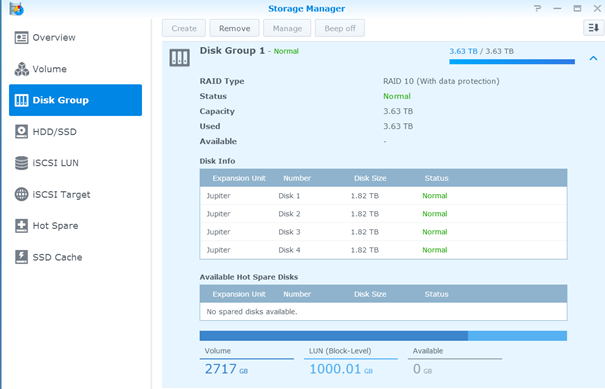
Once disks group is created, I make a volume for my holiday photos shares with 2,61Tb space. Just click on Create in Volume tab, type your volume size and apply configuration.
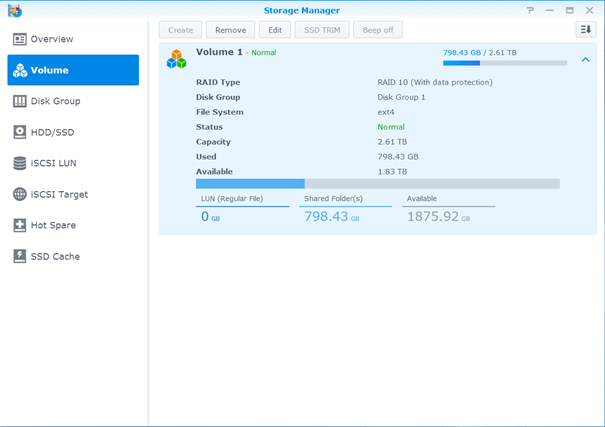
Now, for my virtualization need, I go to the iSCSI LUN tab to create as many LUN I need.
Click on Create in iSCSI LUN tab, select iSCSI LUN (block-level) – Multiple LUNs on RAID. Type a LUN name and configure iSCSI target as needed. Define a storage size and click to create. Repeat the procedure for each LUN needed.
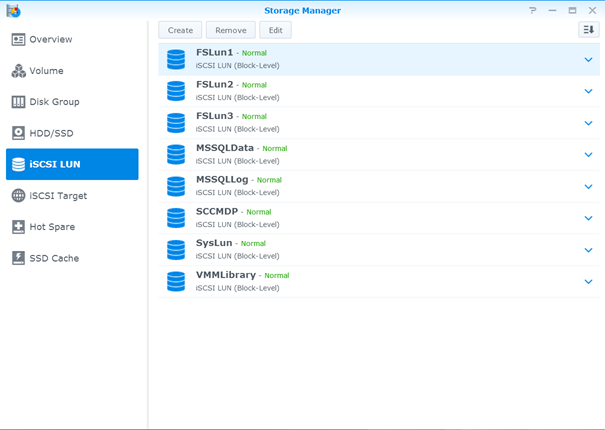
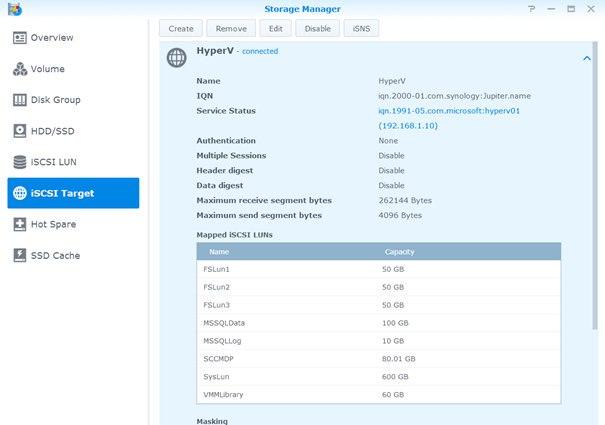
Hyper-V host side configuration
Once you have created your LUN, go on your Hypervisor server. For this example, I work on Windows Server 2012R2 Datacenter where Hyper-V role is installed.
So I open iSCSI initiator in Administrative tools on Hyper-V host and I launch a quick connect on Jupiter target (this target is the name of my Synology). Click on connect and select all LUN. Now all LUN are in disk management of your Windows.
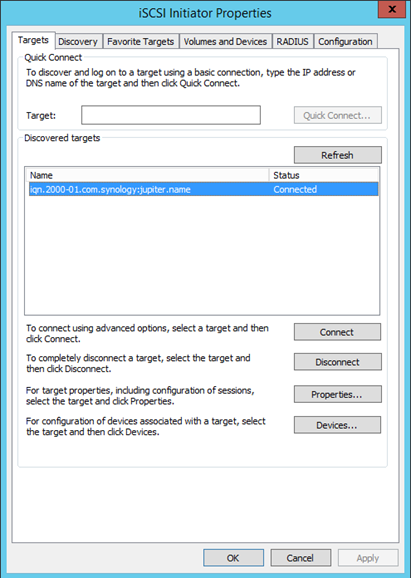
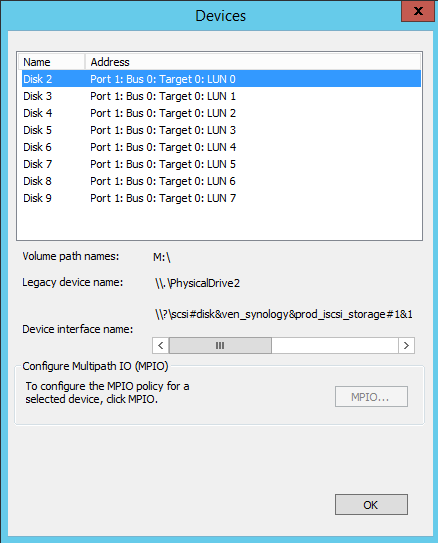
Now you can use these LUN to store VHDX or to make pass-trough disk for your databases for example.
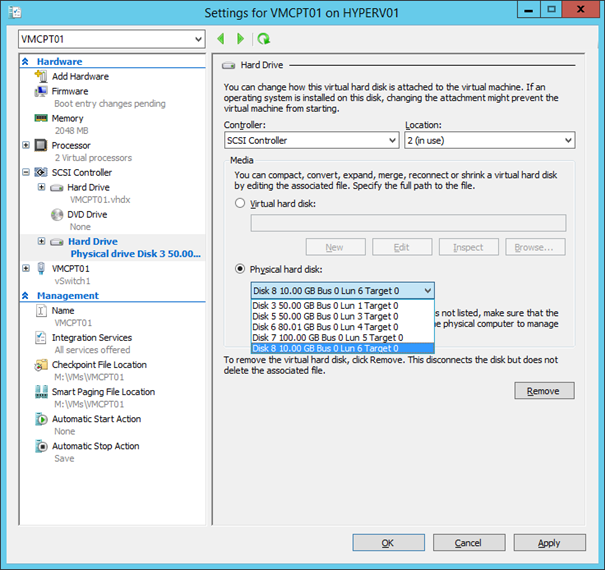
Even if I have only four disks, performance is not ridiculous. I reached the 200MB / s in write and IO meter in resource monitor of my Synology indicate good performance for my lab needs. Sometime the data transfer is faster than my network bandwidth. I think this is ODX which is working. It’s great because I use Virtual Machine Manager 2012R2 and it is able to use ODX for VHDX transfer.
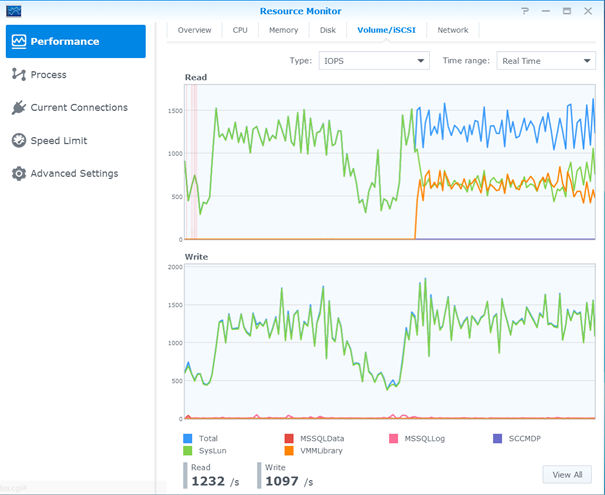
Synology NAS for Hyper-V is a good option
To conclude, Synology provides some SAN features such as iSCSI, LUN or ODX. For a LAB, it’s useful for shared disks and CSV (Cluster Share Volume) disk for Cluster Failover.
In the same time, WAF volume is available to share holiday photos across network to smartphone, TV etc.
Synology disks group provides flexibility to manage its volumes. I think it is a great feature for power user or small enterprise. So next time I braze a fibre channel adapter on my DS412+ … nooooo it’s a joke (but let me think about that … :p)




hello! i setup my ds1813`+ similary to yours but i have just created 1 LUN with 500GBs, connect Hyper-V Host, format that Disk and saved the VMs on that drive. advantage: i dont need to configure every single LUN on Hyper-V.
what do you think about that way?
Hello Alexander,
I have similar configuration to store virtual machine. I have created one single Lun to store all VHDX. But I need additionnal LUNs for pass-through disk (MSSQL usage) or to create Cluster Shared Volume (CSV) for Failover Cluster usage (Scale-Out File Server). My Virtual Machine Manager Library is on a LUN also to benefit ODX.
Create additional LUNs to store Virtual Machine is useful only if you have several disk groups on many different hard disks. In this way you multiple IOPs.
On production environment, it is easier to manage many small LUNs than one big LUN. For example on my production environment we have several LUN sized to 1TB to store virtual machine.
Hope to have helped you.
Hi Romain Serre
While searching hyper-v suppoted NAS I came across your interesting post. I have the following in my private LAB.
1. Hyper-V host (Windows 2012 Data center R2) is Dell 2900 x 48 GB RAM and 3 TB HHD
2. I have about 10-15 VM including SCCM 2012, SQL 2012 on the hyper-host
3. Separate Desktop-like AD DC’s
Now I run out of storage and VM are running slow. How do you see if I use your Synology DiskStation DS216 (or better model if there is one) to move some of the VMs and use it for future created VM?
Hi Endy,
I’m sorry I don’t understand your question 🙂
Hi Romain Serre,
Thanks. What I am saying is can I use the DS412+ as an additional storage for my existing configuration?
Thanks
Sure you can. It is just another iSCSI target 🙂
Hello Romain, I have a 3 node Windows 2012 cluster for my vm’s with DS1512+ for CSV. As I see on synology web my nas is not compatible with windows 2012 R2. Have You tested Your nas as a CSV for windows 2012 R2? I plan to upgrade my system to R2, but I’m not sure I can. What do You think? Thanks. Bence Soponyai
Hi Bence,
On my mockup I use a DS412+ as iSCSI LUN provider. I have a SOFS cluster of three nodes with four CSV. These nodes run on Windows Server 2012R2 and it is working.
I have 20 VMs on Windows Server 2012R2 on my mockup including the Hyper-V host. Everything is working well with DS412+ LUN.
However maybe that Synology will not support you if You have an issue between your hyper-v host and your DS1512+ iSCSI LUN. So if You are in production environment, I not recommend you to upgrade to 2012R2 if the DS1512+ is not supported by Synology.
Thanks, man! I did everything according to your instructions and all went perfectly!
Great article and great sense of humor. Way to go!
I have Synology DS415+ and I was stuck with SMB shares and Windows 10.
With iSCSI all works seamlessly.
Bonjour
Quel est l’intérêt de créer un LUN par VM ?
Je m’explique, à la création de VM, tu sélectionnes un “physical hard disk” plutôt qu’un “Virtual Hard Disk”, est-ce qu’il est plus judicieux d’utiliser un LUN entier pour un vhdx ou on peut mettre plusieurs VHDX par LUN sans problème ?
Que penses tu d’un Synology haute performance (du genre 2416+) en guise de SAN ? (pour un cluster Hyper-V par exemple)
Merci d’avance pour ta réponse
Hi Alex,
It was an example to show that we can pass-through the LUN to the VM. This is not the best practices but it is possible. However, you can create a LUN for several VHDX and this is the recommended way.
Synology is poor in term of performance. If you want only dozen of VMs it is ok but for more, I don’t recommend it. You can now check solution as Storage Spaces Direct, VMware vSAN or Starwind for free which increase performance when two Synology NAS are used.
Please could you translate your comment in English? This blog is in English and I want everyone can understand conversation.
Regards,
Romain
My last post in english
“Hello
What is the value of creating a LUN by VM?
I explain, when creating VM, you select a “physical hard disk” rather than a “Virtual Hard Disk”, is it better to use an entire LUN for a vhdx or you can To put several VHDX by LUN without problem?
What do you think of a Synology high performance (like 2416+) as a SAN? (For a Hyper-V cluster for example)
Thank you in advance for your answer”
Ok do you now what’s the first bottleneck of a synology’s storage? CPU ? RAM ? network ?
Hi Alex,
The first issue regards Synology is the number of controller. In standard enterprise SAN, you have two controllers. If one fails, the other can process. In Synology hardware, you have one controller. So in a Hyper-V/Vmware cluster, Synology is a single point of failure. There is no system to replicate synology AND failover automatically to the other Synology in case of the first fails.
Synology is not a SAN. Its primary purpose concerns file sharing. Synology has added some iSCSI for small environment. The OS is not made for enterprise. You have lot of process that can be taken for other thing than storage. For exemple, for a pure NAS iSCSI, I’d like to remove share processing, user management (except for iSCSI admin), the packet repository and so on.
To finish, Synology NAS are often limited by CPU and RAM. For small environment (10-15VMs) it is good, but beyond I think Synology is not a good option
Regards,
Romain
Super appreciative of this thread! I am getting ready to flatten my D413j and it seems that this is really best suited for *backups*, am I right? The thought of running my VMs from a NAS really seems inefficient to me, especially when my lone Hyper-V (or rather, Windows Server 2016 w/ Hyper-V role) server has 3TB of total disk space.
Unless I am missing something here. It would seem to me that I should use my local disks for my VHDXs and then back them up on a nightly basis with a scheduled backup on my root host machine (which also has the Windows Server Backup role), correct?
Lots to learn here. My head is swimming. 🙂
Doh, I can’t edit. It should read: “back them up on a nightly basis with a scheduled backup *defined* on my root host machine.”
Also, while I am at it… I am seeing chatter around possibly using my Synology as a replica target (as a form of redundancy). But that doesn’t seem good to me either. What I am after is the “proper” way of running all my VMs (I do not run a domain) and have backups of them in case something catastrophic occurs.
With 3TB of storage, you can store your VM locally and use Synology for backup. You can connect LUN inside VM through iSCSI to provide storage to your backup service. I wrote this topic for my lab needs. In production it is not really recommended today especially with softwar solution such as Storage Spaces Direct or Starwind VSAN Free.
Haha well I am total newb here so the furthest from production. 🙂 One last (hopefully!) question… I see that there is a Synology Hybrid RAID, and I am curious on why you chose RAID 10 over this. Thanks for engaging your readers!
I selected RAID 10 because I wanted good performance in read and write. The RAID 5 don’t provide good performance in write.
I don’t trust specific resilience system such as SHR. I prefer to run over RAID (or Storage Spaces in case of Windows Server :p)